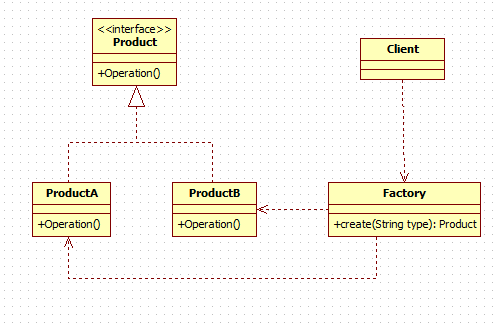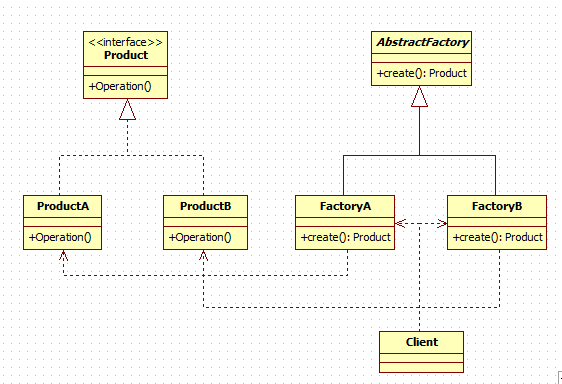
一.概述
工厂模式(Factory Pattern)是 Java 中最常用的设计模式之一,其通过提供对象创建工厂,将创建对象的具体过程屏蔽起来,使调用的客户端不用关心具体的对象创建过程,提高了灵活性。
工厂模式属于创建型模式。
工厂模式根据抽象层的不用,可以分为以下三类:
- 简单工厂模式
- 工厂方法模式
- 抽象工厂模式
其中“简单工厂模式”并不属于设计模式的一种,通俗的说是一种编程经验。
二. 简单工厂模式
简单工厂模式是工厂对象根据传入的参数不同,创建不同的对象实例。
UML类图解析

- Product:产品接口,也可以是抽象类。
- ProductA,ProductB:具体产品实现。
- Factory:根据传入的参数创建具体的产品的工厂,供客户端调用。
代码实现
图形接口定义
1 | package io.github.brightloong.design.factory; |
图形实现——Circle
1 | package io.github.brightloong.design.factory; |
图形实现——Square
1 | package io.github.brightloong.design.factory; |
工厂
关于工厂,最简单的是传入一个参数,使用 if, else或者case做条件判断返回不同的产品实现,也可以使用反射的方法,来消除这些判断条件。
1 | package io.github.brightloong.design.factory; |
客户端调用
1 | package io.github.brightloong.design.factory; |
输出结果
1 | it is a circle |
优点
- 隐藏了具体的对象创建细节,提高了灵活性。
- 便于扩展,添加新的产品时候只需要添加一个新的产品类,修改工厂。
缺点
- 每添加一个新的产品都要修改工厂类在其中添加判断分支(如果没有用反射的方式),违反了开放-封闭原则。
- 如果添加的产品过多会导致类膨胀。
三. 工厂方法模式
工厂方法模式除了对产品类的抽象外,又添加了对工厂的抽象,不再在工厂中进行调用逻辑的判断处理,而是将这个判断放在了客户端。工厂方法针对每一产品都提供一个工厂类,不同的工厂创建不同的产品实例。
UML类图解析

工厂方法模式和简单工厂类似,不同的就是这里对工厂进行了抽象,有了一个抽象的工厂角色——AbstarctFactory。
代码实现
产品实现和简单工厂模式的一样,这里不再给出。
AbstractFactory——FactoryMethod
1 | package io.github.brightloong.design.factory; |
FactoryA——CircleFactory
1 | package io.github.brightloong.design.factory; |
FactoryB——SquareFactory
1 | package io.github.brightloong.design.factory; |
客户端调用
1 | package io.github.brightloong.design.factory; |
输出
1 | it is a square |
优点
- 拥有简单工厂模式的优点。
- 具有简单工厂模式的优点,并且再此基础上满足了开放-封闭原则,系统中加入新产品时,无须修改抽象工厂和抽象产品提供的接口,无须修改客户端,也无须修改其他的具体工厂和具体产品,而只要添加一个具体工厂和具体产品就可以了。这样,系统的可扩展性也就变得非常好,完全符合“开闭原则”。
缺点
- 随着产品类的增加,要提供与其对应的子类,系统中类个数成对增加,在一定程度上增加了系统的复杂性。
四. 抽象工厂模式
上面说道的简单工厂和工厂模式都只能创建一个产品实例,抽象工厂提供了生成多产品的功能。这里很多地方提到了产品族 的说法,比如生产面包的工厂不止生产面包,还会生产饼干、糖果之类的。
UML类图解析

这里有ProductA和ProductB两个产品抽象,并且分别有两个具体实现,抽象工厂AbstractFactory和之前不同的是这里提供了两个生产产品的方法——crateProductA和crateProductB。
代码实现
在之前Shap产品的基础上增加Colro产品,具体代码如下:
Color
1 | public interface Color { |
Color实现——Red
1 | public class Red implements Color { |
Color实现——Green
1 | public class Green implements Color { |
抽象工厂—— AbstractFactory
1 | public abstract class AbstractFactory { |
工厂实现1
1 | package io.github.brightloong.design.factory; |
工厂实现2
1 | package io.github.brightloong.design.factory; |
客户端调用
1 | package io.github.brightloong.design.factory; |
输出
1 | it is a circle |
优点
- 支持了不同类型的产品,更加灵活。
缺点
- 缺点很明显,类膨胀越来越厉害。

